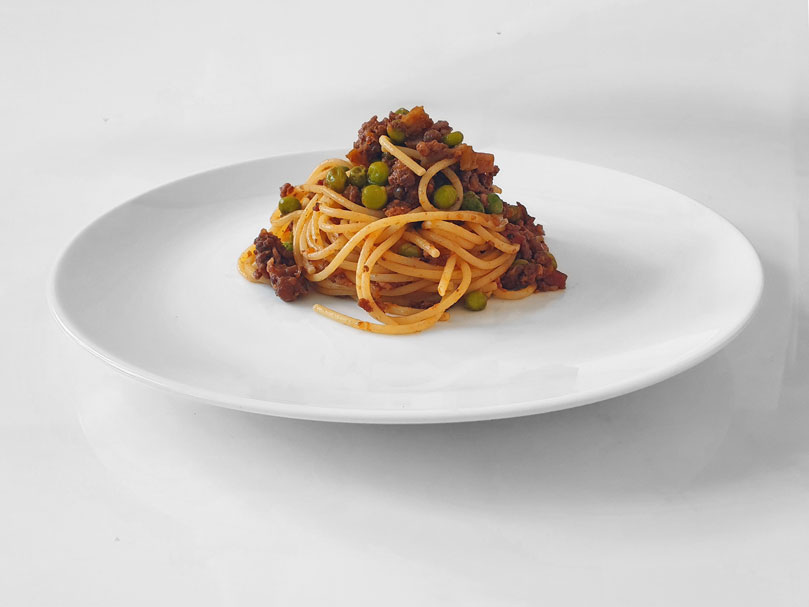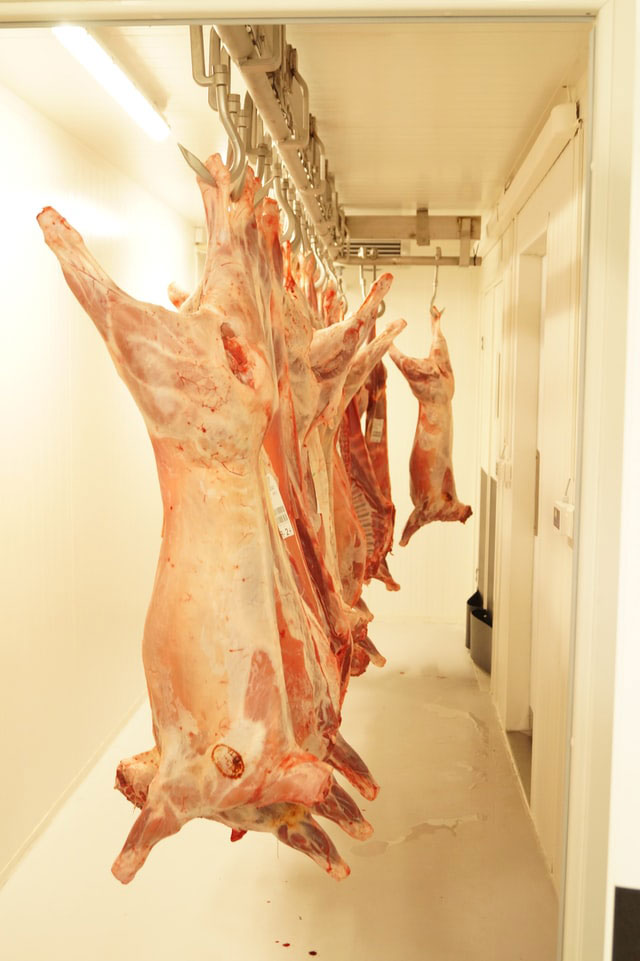
Spaghetti bolognesi is a relatively busy bolognese dish, so in time honoured fashion, let’s take a deeper dive. Here’s a reminder of what’s in store:
SPAGHETTI BOLOGNESI
Ingredienti:
- 200 g di pancetta macinata
- 300 g di pasta di salsiccia
- 300 g di macinato di maiale
- 200 g di cartella di manzo
- 300 g di piselli
- 3 cucchiai di concentrato di pomodoro
- 2 carote medie
- 3 gambi di sedano
- 1 cipolla dorata media
- 1 noce di burro
- 2 cucchiai di olio Evo
- 1 bicchiere di vino rosso
- sale e pepe quanto basta
Preparazione:
Tritare gli odori finemente e farli soffriggere in padella con il burro e l’olio Evo, fino a farli appassire. Aggiungere la pancetta macinata e farla soffriggere, poi mettere il rimanente della carne e rosolarla.
Sfumare con il vino, lasciare evaporare e cuocere a fuoco medio per un’ora e mezza. Se serve, aggiungere un bicchiere d’acqua.
Diluire poi il concentrato di pomodoro in una tazza con poca acqua calda e aggiungere al ragù. Inserire anche i piselli poi aggiustare di sale e di pepe. Dopo aver portato il tutto a temperatura, serviranno altre due ore di cottura. Condire gli spaghetti, che possibilmente dovranno essere di Gragnano.
SPAGHETTI BOLOGNESI
Ingredients:
- 200 g of minced pancetta
- 300 g of sausage meat
- 300 g of minced pork
- 200 g outside skirt of beef (cartello di manzo / harami)
- 300 g of peas
- 3 tablespoons of tomato paste
- 2 medium carrots
- 3 celery stalks
- 1 medium onion
- 1 knob of butter
- 2 tablespoons of olive oil
- 1 glass of red wine
- salt and pepper to taste
Preparation:
Finely slice the onion, carrots and celery and fry them in a pan with the butter and olive oil, until they are soft. Add the minced pancetta and fry it, then add the rest of the meat and brown it.
Deglaze with the wine, allow to evaporate and cook over medium heat for an hour and a half. If necessary, add a glass of water.
Dilute the tomato paste in a cup with a little hot water and add to the sauce. Also, add the peas and season with salt and pepper.
After bringing everything to temperature, it will take another two hours of cooking. Season the spaghetti, preferably from Gragnano.
Il Maiale
Spaghetti bolognesi is a smorgasbord of pig products. Almost unnecessarily so. I think the point il Comitato is making with such a diverse range of pork content, and indeed all other components, is that the dish is often prepared with leftovers.

Pulling those leftovers together from a clean slate feels a little contrived, especially when it generates a whole load of leftovers of its own. However, I’m willing to go with the flow and accept the hotchpotch of ingredients for what it represents.
We’ve already recognised that pork has historically been relatively cheap in northern Italy.
Pancetta, pork mince and the meat from Italian sausages all combine like some kind of poor man’s medley. Our pancetta has been examined in depth and there’s not much to say about the mince, so it’s worth taking a closer look at Italian sausage meat.
In Italy, Sausage meat is often sold like mince is sold in Britain - with the meat not encased in sausage skin. We can buy sausage meat here in the same format, but the same supermarket aisles will be dominated by actual sausages.
Italian sausage meat is also different from ours. The meat is ground to a much coarser texture, with noticeable chunks of pork fat amongst it.
Meat content is higher too, a good quality British banger might be in the region of 85% pork, whereas the Italian equivalent could be up to 97% pork.
If you are a non-Italian with a picture of Italian sausages in your mind, it is probably not accurate. The Italian-American influence, over-represented by southern Italian immigrants, tends to lead to an association that Italian sausage equals sweet sausage. Similarly, there is likely to be a high garlic content.
You can get sausage like this in Italy, but you should consider these to be the outliers. In Bologna, a sausage is likely to be simply seasoned with salt and pepper.
Having fresh Italian sausage meat imported would be madness, so instead I’m going to opt for a local solution. The Salsicciamo brand uses UK pork but prepares this “in the style of” Italian sausages.
La Carne Bovina
The good people of il Comitato have done us a favour, by vindicating our decision to use cartello di manzo rather than finta cartella in our ragù alla bolognese.

I still find it incredible that this open secret of an authentic bolognese (either the tagliatelle or spaghetti versions) appears to be lost on every single English speaking “expert” on the subject.
Throughout my research, I’ve visited hundreds of websites which claim to recreate the “authentic” bolognese, but none of them pick up on this cut of beef. Plenty of worldly Michelin starred chefs have thrown their hat in the ring and offered their own interpretations, but if anything they go the other way, recommending “the best quality” beef mince.
I guess in the click-baity, fast information world of internet recipes there’s no requirement for genuine authenticity. It’s hard to tell the home cook that a bolognese should contain no garlic, nor basil and the inclusion of tomatoes is somewhat contentious. If you then drive home the meat requirements things get even more complicated:
Sooooo.. if you’re reading this in the UK you can get hold of the authentic meat for a bolognese but, most likely, you’ll need to call a supplier for Japanese restaurants and ask for “harami”. It’s going to cost you more than the cut is “worth” because despite harami being on the cusp of offal, supply and demand are not working in your favour. If you’re reading this in the USA, then good luck! Your cattle farmers have almost hocked your country’s entire supply of outside-skirt to the Japanese. This supply is now tied up in long term contracts so your best bet might actually be to have some US harami imported back from Japan. Please plant a tree to offset your carbon footprint. You could try a Latin-American butcher, Mexicans know a good cut of meat when they see it, and their imports will plug the gap left by your exports.
This is not quite the tweet-sized advice an internet recipe normally conveys.
Anyway, I’m happy for this to remain our secret. Cartello di manzo really does add a depth of flavour to the ragù which is hard to beat.
The recipe is not explicit, but I will assume the beef gets the mezzaluna treatment for a course mince.
Sugo
Our sugo feels tried and tested, and by now we should be able to do this with our eyes shut.
A textbook battuto is cooked in a mix of oil and butter. It’s good to see butter being invited to the pauper’s table. I’m assuming the mix of fats is a representative of either the convenience of oil, or the expense of fresh butter, and so a compromise of both is suggested.
The meat is then added, which will offer a lot of moisture, fat and flavour to the sauce. Next comes red wine.
The wine was a little bit of a surprise to me. If this dish says “frugality”, wine feels a little bit extravagant, but it could also represent the previous day’s prime ragù being used for a second time.
To be fair, poor people do love to get on the lash, and Bologna’s poor may have had more wine in their house than fresh food for all I know.
Add to this mix some watered-down tomato paste (which screams austerity) and you have the basis for a poor-man’s bolognese.
Piselli
Just as things are looking so delightfully ordinary, predictable and l’Accademia-like, the star of the dish is thrown in. Peas!

It feels like asking a child what they want with their spaghetti bolognese.
“Peas! No wait, baked beans. No, actually peas!”
I’m willing to cater to this obscure request but just wish the cooking instructions weren’t so clear about the cooking time and left this to my interpretation.
These peas are destined for 2 hours of slow cooking, which is going to be a tough time for these little vegetables.
I did wonder whether Italian peas were hardier than the garden peas we enjoy in Britain, possibly more like the marrowfats used in mushy pea recipes. It looks to me like this is not the case, Italian “country peas” are small and sweet.
We’re just going to have to accept overcooked peas as a nuance of the dish and hope we end up positively surprised by their inclusion.
Spaghetti
Our peasant’s bolognese has quite discerning taste when it comes to spaghetti. I can get behind this idea though.
Imagine one of l’Accademia’s representatives at home, his family away for the weekend so he’s free to dress in his wife’s underwear and sample the forbidden side of bolognan cuisine, without anyone knowing.
Il Comitato has one shot at convincing him spaghetti and ragù alla bolognese make a good mix. They don’t want there to be any doubt about the quality of the pasta.
We’ve already discussed how the Gragnano pasta seal guarantees us the finest durum wheat with an intimidating protein content.
The most prominent brand to market Gragnano pasta in the UK is Garofalo. The similarity with the children’s book bad-guy isn’t lost on me.
A Garofalo? What’s a Garofalo?
A Garofalo! Why, didn’t you know? He’s grown from wheat on Napoletan lands, has tasty yellow al dente strands, with protein levels in the highest bands.
Where are you meeting him?
Anywhere, from here to Timbuktu, and his favourite sauce is bolognese ragù.
I wait with baited breath to sample this top shelf pasta, and I applaud the rebels who made spaghetti bolognese an official dish!

